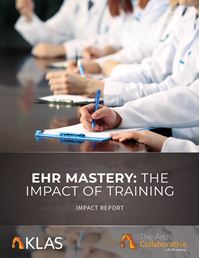EHR Mastery—The Impact of Training
Don't Go Chasing Waterfalls
Organizations occasionally look for a magical solution that will fix clinician dissatisfaction with the EHR. Unfortunately, because education is a human experience, there isn’t any one training program that will magically solve this dilemma. But what has been made clear—by analyzing survey responses from over 40,000 end users—is that good training has a profound and lasting impact on a clinician’s satisfaction with the EHR.
Want to see full details?
Want to see full details?
Here is my information:
Good Training, Bad Training
EHR satisfaction begins with initial training, and providers are more satisfied in the long run when they start off with a good experience. In fact, how clinicians rate the quality of their initial EHR training explains nearly 50% of the variation in their EHR satisfaction.

Impactful Practices1
EHR satisfaction begins with initial training, and providers are more satisfied in the long run when they start off with a good experience. In fact, how clinicians rate the quality of their initial EHR training explains nearly 50% of the variation in their EHR satisfaction.
What makes for good training? Here are three practices that could positively impact your organization.
- Focus on the who, not the what. The quality of the trainer matters more than the structure of the training.
- Expect engagement from clinicians in mastering the EHR—at least 7 hours of initial EHR education and at least 3 hours of annual follow-up education.
- Deliver training that adds value and yields high demand. A few organizations have achieved this through off-site training.
Less Impactful Practices
Often, organizations will institute one of the following programs with aspirations of immediate improvement in EHR satisfaction. While some organizations find success with these options, on average they are not proven to have a significant impact.
Requiring Ongoing Training2
- Requiring ongoing training rather than making it voluntary increases EHR satisfaction by only 3.9%.
Insisting That Clinicians Teach Clinicians
- 55% of satisfied organizations have primarily non-clinicians EHR instructors.
Offering a Test-Out Option
- Epic customers3 see a .76 (.3%) increase in EHR satisfaction when providers can test out of some training and a 3.6 (1.8%) point increase when they can test out of all training.
Self-Assessment
- Would I enjoy going through our existing training programs?
- Do we expect all new clinicians to go through 7+ hours of initial training?
- Are our training opportunities in high demand?
[1] Supporting data can be found in the full report, “EHR Mastery: The Impact of Training”
[2] Although requiring ongoing education has very little impact, offering it and encouraging participation should still be a priority.
[3] Sample sizes for other vendors’ client bases were too small for findings to be shown.
Report Non-Public HTML Body
Report Public HTML Body
This material is copyrighted. Any organization gaining unauthorized access to this report will be liable to compensate KLAS for the full retail price. Please see the KLAS DATA USE POLICY for information regarding use of this report. © 2019 KLAS Research, LLC. All Rights Reserved. NOTE: Performance scores may change significantly when including newly interviewed provider organizations, especially when added to a smaller sample size like in emerging markets with a small number of live clients. The findings presented are not meant to be conclusive data for an entire client base.




